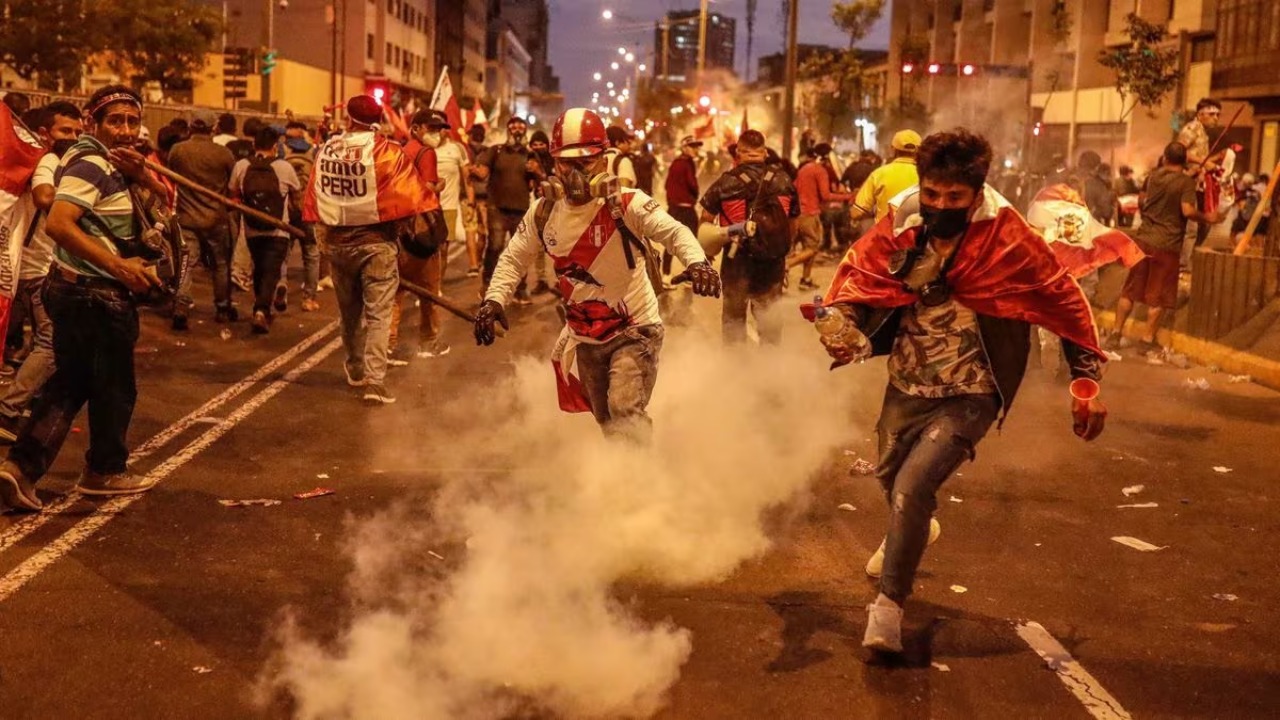Peru 2022: A democracy carrying burdens
Published:
“The response to the protests has been an “institutionalized disdain.” (…) Far from attempting to establish a dialogue with the protesters, part of the Peruvian establishment has chosen to ignore the excesses of the police and armed forces.”

Since 2016, Peru has been immersed in a political and institutional crisis that seems to have no end in sight. With six presidents in just six years, what should be an exception for any democracy has become a “new normality.” The latest chapter of this institutional crisis features Pedro Castillo, who was elected president in 2021, and whose government has been marked by a high turnover of government positions, allegations of corruption, presidential impeachment motions, and an attempted self-coup that led to his police capture and removal.
On December 7, Castillo faced his third presidential impeachment motion. Despite the support from the ruling party and other sectors of the legislature, hours before the vote, Castillo announced the dissolution of Congress, the call for new congressional elections with constituent powers to draft a new Constitution, and the reorganization of the justice system, the Judicial Power, the Public Ministry, the National Council of the Judiciary, and the Constitutional Court, among other institutions.
This attempted self-coup resembled the one perpetrated by Fujimori in 1992, albeit with certain nuances. Castillo did not enjoy the popularity or political and social support Fujimori had. Thus, Castillo’s authoritarian attempt lasted less than two hours before his capture by his security detail while allegedly trying to reach the Mexican embassy to seek political asylum. Meanwhile, the Peruvian Congress advanced its session and ousted Castillo with 101 votes in favor out of 130. Thus, the then-vice president Dina Boluarte became the first woman to preside over the Peruvian Executive branch.
Castillo’s actions have caused irreparable damage to the sectors he was supposed to represent: Peruvians from provinces with fewer resources and opportunities. Far from it, Castillo governed in a clientelistic manner, and both he and his political circle face a significant number of investigations for alleged corruption offenses. However, Castillo is not solely responsible for this crisis. Alleging “moral incapacity,” the Peruvian Congress has the power to initiate a presidential impeachment process based on arbitrary arguments. This has led to a power struggle that effectively limits the governing capacity of anyone occupying the presidential seat.
Protests and Barbarism
The end of Castillo’s presidency and Boluarte’s inauguration as the new president did not mean the end of the Peruvian crisis. This latest institutional crisis has sparked a wave of citizen protests in both the capital and various regions of the country. Most of these protests aimed to advance elections to renew both the Executive and the Legislature and put an end to the absurd conflicts between the branches of government.
Unfortunately, in Latin America, social protests have always been met with violence and repression by governments instead of dialogue and consensus. Peru is no exception. At the time of writing this article, 28 people, including four minors, have lost their lives due to the actions of the police and armed forces. Police repression has reached such a level that international organizations like Human Rights Watch have denounced the abuses and suggested conducting exhaustive and independent investigations under civilian authorities.
The violence has intensified, especially in Ayacucho, where, according to reports from Human Rights Watch, the Peruvian government deployed armed military personnel. The Ombudsman’s Office reported that 356 demonstrators and 290 police officers were injured during the protests. Likewise, the National Coordinator for Human Rights in Peru stated that the police assaulted arrested individuals or during their custody, delayed the access of lawyers to detained persons, and detained many of them for longer than allowed.
The police excesses should be understood in the context of the government’s response to the protests. Once in power, President Dina Boluarte declared the entire Peruvian state in a state of emergency for 30 days on December 14. This exceptional measure, provided for in the Constitution, suspended some basic rights such as freedom of assembly and inviolability of domicile, and mobilized the armed forces to various provinces in the country.
This level of police violence directed at protesters has been the rule rather than the exception. Peru has a long history of human rights violations during protests. In 2020, during the institutional political crisis of that year following Manuel Merino’s rise to power, two young men, Brian Pintado and Inti Sotelo, lost their lives in the marches. The deaths of Inti and Brian marked the end of Merino’s presidency and strengthened social pressure on Congress to find a democratic solution.
Political scientist Jo-Marie Burt defined the Peruvian crisis not only as a political and institutional crisis but also as a human rights crisis. Protests in Peru have become increasingly violent, occupying airports and blocking roads. In this new crisis, the decision to mobilize the armed forces has had a negative impact on the lives of citizens, as this organization lacks the organization or equipment to carry out these tasks. On the contrary, their actions have only intensified the levels of violence.
The response to the protests has been an “institutionalized disdain.” Both the current president and various congress members and journalists have indicated that the demonstrations are the product of “bad Peruvians” or “terrorists.” Far from attempting to establish a dialogue with the protesters, part of the Peruvian establishment has preferred to ignore the excesses of the police and armed forces. With nearly 30 deaths, the least the Peruvian government should ensure is a thorough investigation and justice for the victims. However, in Peru, this will not be the case as Boluarte stated that the deaths during the protests will be investigated in a military forum.
A “Way Out” of the Crisis
After 28 people died during the demonstrations, the Peruvian crisis persists. Boluarte’s response to the protests was to bring forward elections to change both the Executive and the Legislative branches for 2024 instead of 2026. Although certain sectors of the population demanded the organization of these elections in 2023, on December 20, Congress approved the advancement of elections for April 2024. The approval of this measure will need to be confirmed in the next legislative term.
Despite this possible way out of the crisis, there are certain institutional elements that, if they persist in the Peruvian political system, will trigger a new crisis regardless of whether the Executive and Legislative branches are renewed. These are the insolvency of government parties to obtain (or agree on) majorities in Congress and moral incapacity as grounds for presidential impeachment. Both factors remain present in the Peruvian system.
Due to the party crisis and the high fragmentation within parties, government parties in Peru have had great difficulty in obtaining majorities in Congress. Thus, in the General Elections of 2001, 2006, 2011, 2016, and 2021, government parties only accumulated 37.5%, 30.0%, 36.2%, 13.8%, and 13.4% of seats, respectively. In no case have governments managed to generate effective alliances between parties. This disparity between the number of government blocs and the opposition has resulted in constant conflicts between the Executive and the Legislature. Without a strong government party, conflicts between the branches will continue.
The second factor, which must be resolved promptly, is of a constitutional nature. Specifically, the presence of impeachment due to moral incapacity as grounds for the president’s removal. The term “moral incapacity” was only used before 2016 in a single case: Fujimori’s resignation and departure from the country after a corruption scandal. This exceptionality was interrupted from the minority government led by Pedro Pablo Kuczynski and has been used by the opposition with alarming frequency. Impeachment due to moral incapacity resulted in Kuczynski’s resignation, the removal of Martín Vizcarra, his successor in the presidency, and Castillo’s attempt at a self-coup to avoid his removal.
Although Peru has once again avoided falling into an authoritarian regime, Dina Boluarte’s rise has only triggered massive protests from a population already tired of political instability. Instead of dialogue, the government has responded with extreme violence. Peru closes the year with a democracy burdened, weak, and deeply disconnected from the needs of the citizenry, especially those outside the Lima Metropolitan area.

Leave a Comment